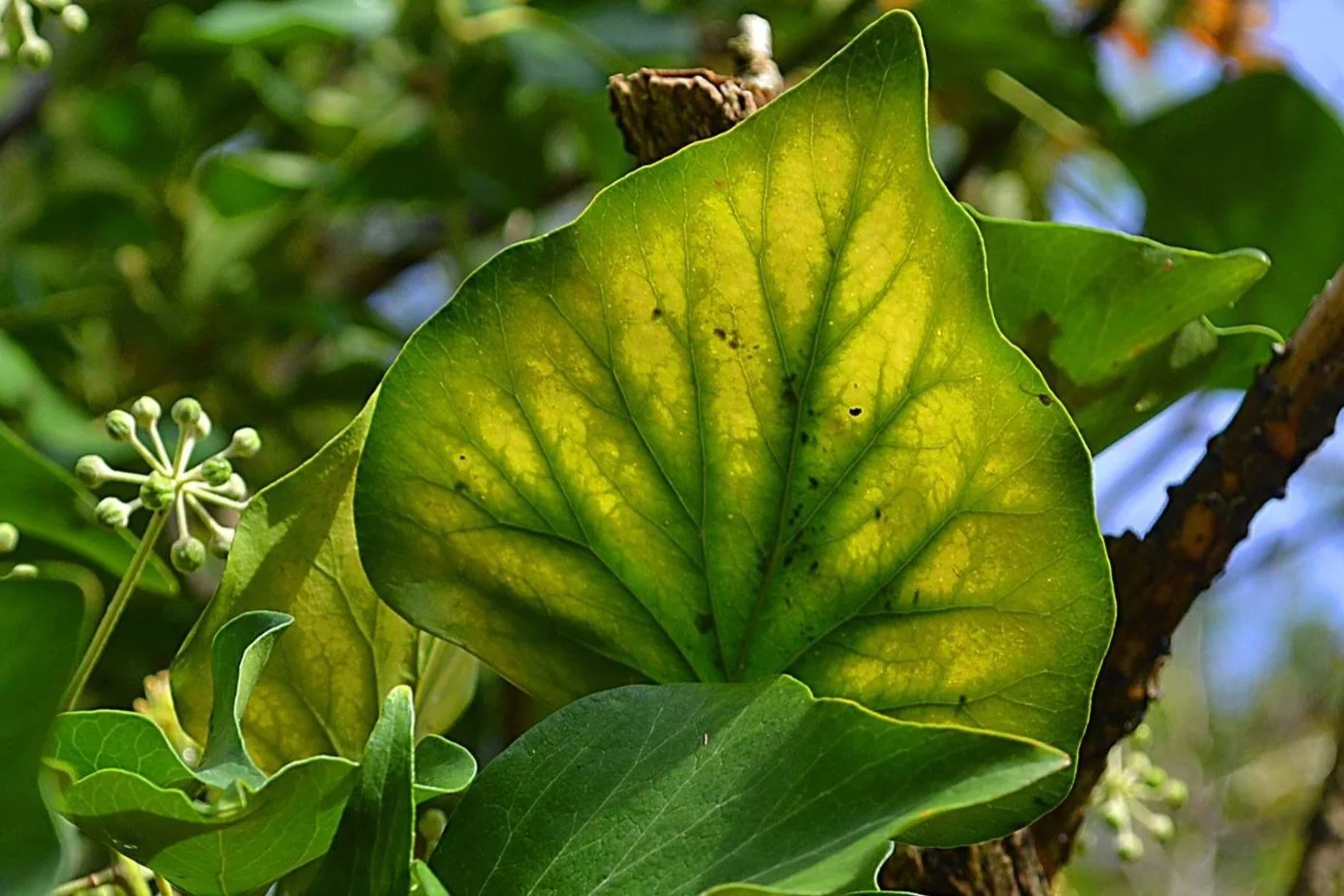Image courtesy of Chris Shepheard
Photosynthesis is the process that has made life on earth as we know it possible. It generated oxygen to a concentration where complex life forms could be sustained and reduced carbon dioxide [CO2] to cool the planet. It provides all the energy for the biosphere in a usable form. Yet because green plants are commonplace and the process itself is invisible, we completely take for granted what is a truly remarkable process. To my taste it is far more interesting than anything any animal does. Of course, as fascinating as it is, the detail becomes very involved so my aim here is to outline the essentials and then ramp up the detail to give those interested the option of going deeper into it.
Photosynthesis converts electromagnetic radiation in the form of visible light into chemical energy. It converts something that is ephemeral into something that can be stored and modified. It puts together five components: Light, water, CO2, clever chemistry and organization to get there. First the energy of light is captured. Next the energy is used to split water into oxygen and hydrogen [protons]. Lastly, the protons are used to ‘fix’ carbon dioxide adding it to an existing sugar making it bigger by one carbon [and the two protons and one oxygen characteristic of carbohydrate]. Life in all its diversity and abundance derives from this product or ‘photosynthate’ either directly [as structure] or indirectly [as an energy source].**
Image courtesy of Jonathan Durham ARPS
The sun provides the energy for photosynthesis as most people know. Almost half the energy of the sun is visible light. Of that, only the energy of red and blue light is available for photosynthesis since green light is reflected away; the reason leaves are green is because the light-catching pigment, chlorophyll, reflects green while absorbing red and blue light. The colours we see light to be correspond to different energy levels they carry. A particle [photon] of blue light has more energy than a particle of red light and together they provide sufficient energy to split water as mentioned above. The other, approximate half of the sun’s energy is called infra-red, sometimes referred to as radiant heat but this radiation is insufficiently energetic to propel photosynthesis.
The thread-like structures are double membranes which have embedded in them the structures that hold the biochemical structures in order, both for the light and dark processes. Note the scale which is 1 micron or 0.001mm.
Botany, an Introduction to Plant Biology, 4th edition, 1970. Stocking, Barbour and Weir
A diagram of a typical leaf cross-section. CO2 ingress is through the stomata, through the intercellular spaces, into the cells and, at last, into the chloroplasts. The veins have two tissues; Xylem conducts water to the leaf, Phloem exports ‘photosynthate’, the product of photosynthesis, to the rest of the plant.
Image source: Botany, an Introduction to Plant Biology, 4th edition, 1970. Stocking, Barbour and Weir
In the plant leaf, two separate but coordinated processes take place. The ‘light cycle’ is the capturing of light energy, its conversion to chemical energy via chlorophyll and it’s use to split water [H2O] into oxygen which is liberated and hydrogen which is bound to an intermediate. The second process is called the ‘dark cycle’ or Calvin cycle’ which uses the hydrogen to add CO2, to a sugar making a bigger [by one carbon] sugar. In this form it can be utilized by the plant either to make more plant or broken down to provide energy to make more plant. In fact there are three identified dark cycle mechanisms which we will discuss later. You may have heard of C-3 photosynthesis, found in broad-leafed plants and C-4 photosynthesis, found in grasses but probably not of Crassulacean acid metabolism, found in cacti and succulents.
The above outline covers the first four components, light, O2, CO2 and clever bio and photochemistry. You might well already have the impression that all these remarkable transformations can’t take place in some sort of soup, something that could work as long as all the ingredients are present. You’d be correct. The organization begins at the molecular level through the sub-cellular level where 0.0001mm is a long way, then the cellular level where we find different cell types arranged anatomically in the leaf and the leaves organized on a frame we refer to collectively as the ‘plant body’.
Chlorophyll molecules are arranged in conical groups of perhaps 250 along with ‘complimentary pigments’ which also absorb light and pass the energy to chlorophyll [carotenoids and anthocyanins are orange, red or purple and usually obscured by chlorophyll, until autumn]. These entities are formed into sub-microscopic particles that are bound to membranes that also contain the other biochemical components required. These membranes are contained in ‘organelles’ called ‘chloroplasts’ or just ‘plastids’ which are easily visible with a light microscope. With an electron microscope the membranes can be seen to be formed into regions, grana lamellae and stroma lamellae, that correspond to the light and dark cycles described above. Plastids are found primarily in two types of leaf cells that lie between the upper and lower epidermis called spongy mesophyll and pallisade layer. But the plant has a problem yet to overcome: allowing CO2 to flow in also allows water vapour to flow out.
Image courtesy of Jonathan Durham ARPS
So now we must discuss the importance of water to plant structural integrity. Everyone is aware that plant leaves wilt if they lack water. Water deficit occurs when water loss from the leaves exceeds the ability of the roots to extract water from the soil and for the stem to conduct it up to the leaves. It would be easy to minimize water loss except that in order to get CO2 into the leaf for photosynthesis leaves must be porous. The solution is to have an epidermis coated with a waxy, impermeable material [called suberin] punctuated with pores called stomata which are protected by two ‘guard cells’ which control the opening of the pore. If water loss becomes too great, stomata will close and CO2 availability falls away. There are many more stomata on the lower epidermis than the upper surface.
We’ve added a little more detail about light, water, biochemical and structural considerations which leaves the last piece of the photosynthesis process - CO2. When I was doing photosynthesis measurements in the ‘70’s by measuring CO2 levels before and after passing over a leaf, we would calibrate the machine [called an Infra-red gas analyzer or IRGA] using the ambient CO2 level which was 330 parts per million [ppm] or 0.033%. Now that concentration is about 420ppm. As photosynthesis takes CO2 out of the air inside the leaf a concentration gradient is formed from this low concentration inside the leaf to a higher concentration around the leaf. This produces mass flow [called diffusion] where CO2 molecules move from the higher concentration of the air to the low concentration where CO2 is being removed. Instinctively one might feel as though CO2access into the leaves through tiny channels could be slow and inhibit photosynthesis rates but in practice it is the closure of stomata due to water stress that limits photosynthesis in high light conditions.
Just how much energy does it take to split water, I hear you ask? I mean, photosynthesis takes place even in indirect light, even in heavily shaded glades. The theoretical energy requirement is for 4.3 kilowatt hrs to split a litre of water. In fact, industrial processes, since there is no such thing as 100% efficiency, require 5.5 kilowatt hrs per litre - that’s a thousand watts for five and a half hours!
Understanding the various mechanisms for carbon fixation starts with counting carbon atoms. Carbon fixation in broad-leafed plants is 5 + 1 [CO2] which is immediately broken down to two 3-carbon compounds [hence C-3 photosynthesis]. The 3-carbon compounds are such that they slot into general respiratory activity. The enzyme is called ribulose diphosphate carboxylase [RuDP carboxylase], ribulose being the 5-carbon molecule.
With grasses you get 3 + 1 [CO2] to form a 4-carbon compound [hence C-4 photosynthesis] which can also slot into general respiratory activity but at a different pathway than C-3. This enzyme is called phosphoenolpyruvate carboxylase [PEP carboxylase], enolpyruvate being the 3-carbon carbohydrate. In terms of performance, Pep carboxylase has a higher affinity for CO2 than RuDP carboxylase in the lab but it isn’t clear if this produces higher C-fixation in the field because there are other potentially rate-limiting steps.
Crassulacean acid metabolism [CAM] also utilizes PEP carboxylase but it’s activity is modified to avoid the excessive water loss that would occur in their desert habitat. Only during the night stomata open and CO2 is fixed using chemical energy to produce a pool of 4-carbon organic acid. The ‘acidic’ group of an organic acid is essentially CO2 so during daylight the stomata remain closed, the acid group is hydrolyzed off to provide the CO2 inside the plant body and C-4 photosynthesis can take place as described above. Clever stuff.
**There are other chemical reactions that fix carbon aside from photosynthesis and ‘chemolithotrophic’ bacteria harness inorganic chemical reactions but it is estimated that 90% of all carbon fixed is via photosynthesis
Mick Frank
Image courtesy of Jonathan Durham ARPS







